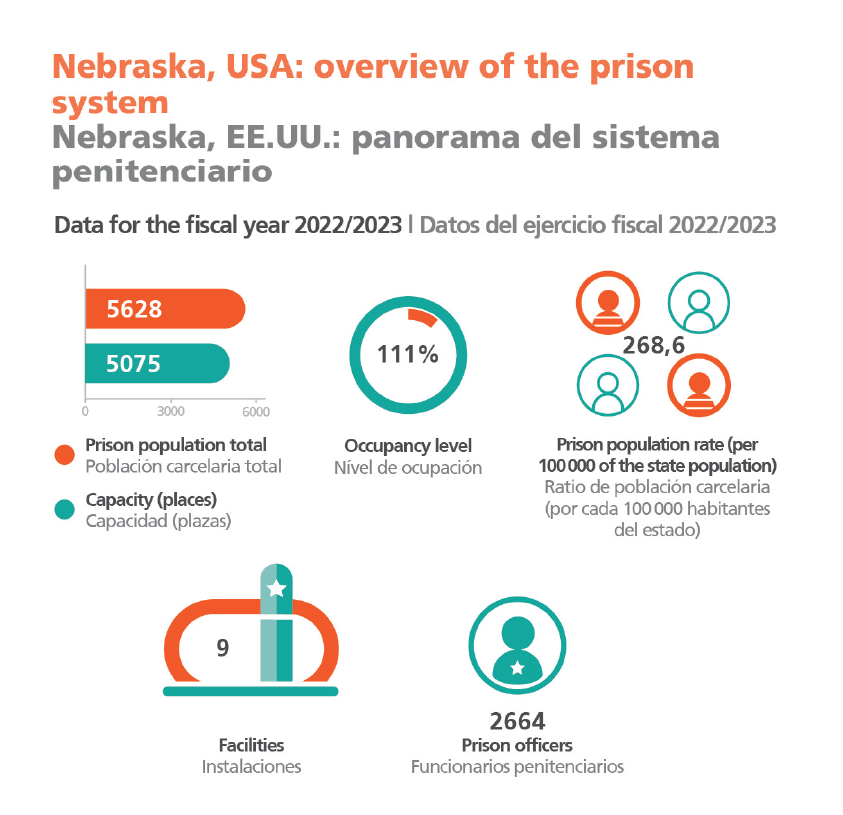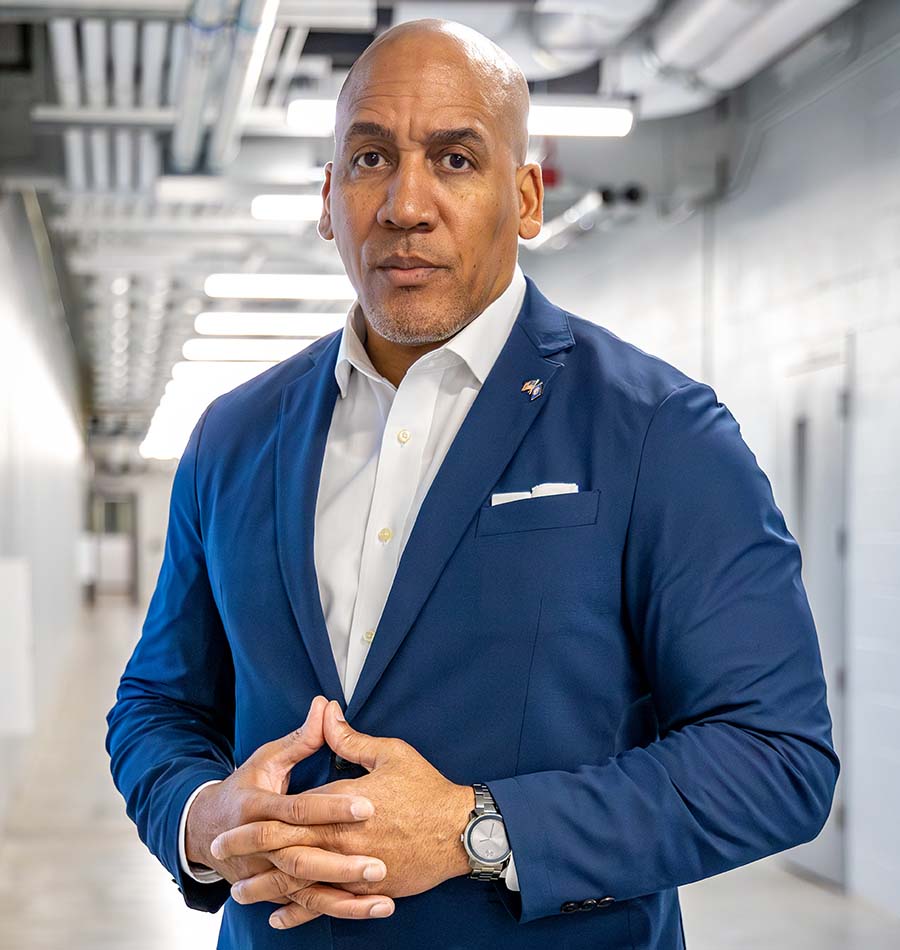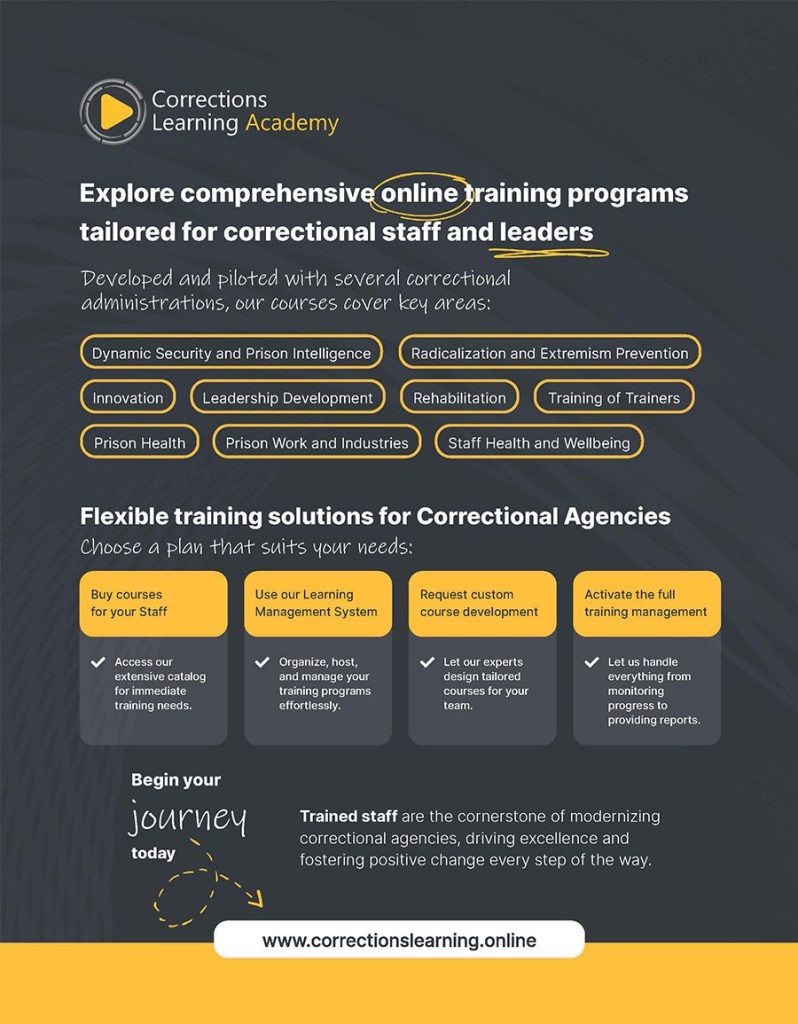Interview
Rob Jeffreys
President of the Correctional Leaders Association & Director of the Nebraska Department of Correctional Services, USA
What strategies that worked in Illinois are you striving to replicate at the Nebraska Department of Correctional Services?
RJ: In Illinois, and now in Nebraska, I’ve found that having a strategic working plan is key to managing agencies effectively. We start by figuring out our goals and strategies as a team, then we prioritise what we want to tackle first. We do this by asking ourselves what we do well, where we could improve, and lastly, how we can address those opportunities for improvement.
This blueprint was put in place very early on in my tenure at Illinois and guided us throughout when addressing population management, staff development, failing infrastructure, and setting up any type of innovative programming.
One of the things that we created in Illinois, very early on, at the onset of the COVID-19 pandemic, was a population management task force. We focused on understanding the population dynamics within our state correctional institutions. We delved into the data analysing our shortterm and long-term offenders, and why some of them were not being successful in parole and were coming back to prison. We also examined the programming components that were in place, and the risk and needs assessments done inside prison and outside on parole, gaining insight into what was failing in their reintegration.
This continuum of risk and needs assessment embedded into our population management allowed us to provide targeted programming throughout an individual’s incarceration and parole. Based on their particular needs, we could get the right person, in the right programme, at the right time.
This stratified approach to population management also lends itself to be applied to people on supervision. Instead of a blanket approach based on “time and crime”, as we did before, we could focus on varying risk levels, from low to moderate, medium, or high risk. This is one of the measures that has proven effective in Illinois, leading to a reduction in parole caseloads.
Nebraska already has this strategy in place, so it’s a matter of aligning what risk and needs assessment offers for case management in parole supervision. The main difference is that while I oversaw the parole division in Illinois, the NDCS does not supervise parole*. This requires added collaboration with other departments to make this happen.
Another significant development in Illinois was the establishment of a re-entry division, focused on ensuring individuals leaving incarceration received the necessary documents, and in connection with the community, that they had access to housing and employment opportunities. When I came to Nebraska, this was one of our focal points, refining their already existing re-entry division, incorporating fresh ideas, and fostering collaboration with other state departments and providers in the community.
*In April 2024, the Nebraska Legislature passed LB631, which transfers the Division of Parole Supervision to the Department of Correctional Services. This will go into effect July 19, 2024.

Could you elaborate on some of the initiatives and programmes in place in NDCS to support inmate rehabilitation, and facilitate successful transitions back into the community?
RJ: Another successful approach that worked in Illinois, was incentivising the prison population. Here in Nebraska, we’ve just launched a similar concept as part of our Reentry 2030 programme, which we’re calling TRANSFORM Nebraska. It’s essentially an incentivised population management model aimed at fostering a culture of improvement.
Moving beyond the focus on risk and needs, towards promoting personal growth, this approach includes the “5-Key Model for Reentry and Wellbeing Development”. This innovative model emphasises wellness through healthy thinking patterns, positive relationships, effective coping strategies, positive social engagement, and meaningful work trajectories.
These activities are peer-led, also involving staff trained to support them. We began by training over 200 individuals to serve as peer support facilitators. This creates a culture where our residents are invested in each other’s success.
When peers support one another in programming, it fosters an environment where everyone is rooting for each other's progress, which is crucial.
Additionally, we introduced a new programming platform on our tablets featuring educational, vocational, and rehabilitative content and curricula, including learning videos and exercises, which are also layered into the 5-keys model.
Along with the launch of Reentry 2030, which involves collaboration with other state cabinet members, education initiatives, Pell Grants, and the Department of Motor Vehicles providing IDs and documentation for individuals re-entering society, we’re also partnering with our Department of Health and Human Services to ensure individuals leaving our facilities have health insurance coverage.
All these elements embody the essence of TRANSFORM Nebraska. The community understands our goals and expectations as we move forward, aiming to promote a culture conducive to success. I cannot stress enough that success will require not just the efforts of our department, but also the collaboration of other state agencies, the community, families, and the individuals themselves.

What is your strategy to involve and empower staff in this approach?
RJ: Circling back to our strategic plan, it’s all about fostering a culture aligned with our mission of rehabilitating people so they are better when they leave than when they arrive.
It’s vital to ensure this message resonates throughout the agency, across all departments and staff, as well as with the incarcerated population and the community. We must set clear expectations and guidelines for fulfilling our mission of maintaining safety, transforming lives, and reintegrating individuals into society, enhancing community safety.
Our strategic plan is based on four pillars, which I call the four P’s: People, Programming, Policy, and Physical plant. As for our focus on people, we’re dedicated to equipping our team members with the most up-to-date training so they can effectively carry out their assigned tasks in line with our mission.
Staff wellness is paramount; this job is inherently stressful, not only due to the environment and the potential of violence but also because staff spend extended periods behind steel gates, sometimes working double shifts due to the current staffing shortages.
We have to make sure we’re taking care of their holistic wellness, providing a safe environment, and ensuring additional support and resources if they need extra help.
Our recruiting efforts include raising salaries and providing incentives, however, we’re losing staff as fast as we’re recruiting them. We need to focus on retention efforts, which entail enhancing leadership development, promoting staff wellness, and fostering a positive environment where they want to come to work.
Investing in leadership development for our first-line supervisors is essential; after all, I believe that people don’t leave agencies, they leave supervisors.
Can you share your perspective on the importance of using research and data to inform decision-making as a means to improve outcomes and enhance the overall efficiency and effectiveness of corrections?
RJ: My very first job in this field was as a research associate. The principles of using data to make informed decisions, to understand the underlying causes and to identify success metrics have been ingrained into every position I’ve ever held.
I used those methodologies when I was a warden, to measure success at the facility level; I used it as a regional director, where I expected each warden whom I worked with to do the same; and, I use it as a director, starting every meeting with data: incoming and outgoing population, programme completions, indicators of success, violence rates, and opportunities for improvement.
In my role as chair of the Racial Disparity Committee for the Correctional Leaders Association, we use data to understand population dynamics and disparities within agencies, and partner with national entities to address racial disparities on a broader scale.
Research and data analysis in population and facility management are paramount moving forward, as they allow us to explain our actions, establish metrics for success, and identify the underlying causes of many issues. Once we understand the “why”, we find the opportunities for putting action steps in place.
For instance, consider the use of restrictive housing. By examining violence indicators at the facility level – such as fights, assaults, deaths, or the need for protective custody – we can delve into the data to understand when incidents occur, and who is being affected.
When we understand that these assaults are happening on this particular set of population, at this particular unit, by these particular individuals, then we start addressing the root cause of a problem, as opposed to its symptom.
We can apply this to metrics for staffing – how many people are being recruited and how long they’re staying – and then delve into the reasons behind employee turnover.
Often, issues can be traced back to frontline supervisors, workplace environments, or differences in shifts. Sometimes, the job simply isn’t the right fit for some people. By applying research, we can better understand our challenges and find a common thread to individual stories.
How can technology and modernisation contribute to transforming
corrections?
RJ: Prior to the COVID-19 pandemic, I can speak for Illinois, the use of technology was minimal, especially in terms of providing video communication. When in-person visits were halted due to the pandemic, we had to quickly pivot to video visitation and courts were able to implement systems for video hearings. Additionally, we began using tablets to facilitate communication and provide programming.
Speaking from my experience, the pandemic forced us to adapt. We had to move past the fear of potential challenges and instead focus on the opportunities technology presented.
There’s still a lot of ground to cover, particularly in integrating workforce technology within correctional facilities. The truth is that in many facilities, we are still counting every inmate with a pencil and a piece of paper!
To keep up with today’s workforce, especially the younger generation, we must embrace the technology that’s prevalent in society within prisons. There’s a clear need for modernisation, and I fully support it. We need to be proactive and willing to take calculated risks, embracing new technologies.
It's essential to integrate technology into training and vocational skills development for the incarcerated population so they can be competitive upon re-entry into society.
Our digital programming platform, for instance, is incredibly innovative. It streamlines programming and interaction, allowing teachers and counsellors to create case plans tailored to individual needs via a tablet. Being able to have one teacher broadcast to the rest of the agency is extremely useful at a moment when we’re short of educational professionals.
The ability to connect individuals with community resources through video conferencing, even if they’re housed hours away from their community, ensures a smoother transition back into society.
What are the main goals for your mandate as the President of the Correctional Leaders Association (CLA)? In what ways do you see networking and collaboration organisations such as CLA and the International Corrections and Prisons Association (ICPA) positively influence correctional leadership and practices?
RJ: I am incredibly blessed to be where I am in life. Statistically speaking, I could easily be on the other side – incarcerated – based on my upbringing or family dynamics. With that perspective, I fully embrace my purpose, driving me to make the most of my current position.
With that being said, there is a very relevant adage that comes to mind when I think of the role of these organisations: “You only know what you know.” We’re all grappling with similar issues right now: ageing facilities, staffing shortages, and exploring successful re-entry programmes to prepare individuals for life outside. Moreover, there’s a shared challenge of bridging the technology gap in our facilities.
Organisations like CLA and ICPA serve as platforms for bringing people together to share best practices, training opportunities, and insights into these challenges that are common across different states or continents.
It’s important to recognise that each state or country has its own starting point, with varying resources and constraints. What works in a wealthier state might not be feasible in one with fewer resources. However, through open discussions and exchanges, we can find common ground and move forward together.
I believe that, at its core, this networking and collaboration is the best way to foster leadership development, which is especially crucial in our particular profession at this juncture. We can’t afford to overlook the importance of sharpening our own skills amidst the demands of our roles. Sometimes, this means seeking out refresher courses or training modules specifically designed for leaders.
Being part of CLA and ICPA, one of the things that I hope to bring to both platforms, is this ability to invest in those individuals who have to sit at the table to make strategic decisions and navigate challenging situations. How do we equip them to make informed decisions? This question is central to our efforts to enhance leadership capacity within our profession.
Moving forward, I believe it’s vital for CLA to ensure that we’re providing leaders with the necessary tools and support so they can confidently step into the arena, ready to tackle the challenges of fulfilling their mission.
Rob Jeffreys
President of the Correctional Leaders Association & Director of the Nebraska Department of Correctional Services, USA
Rob Jeffreys has been leading the Nebraska Department of Correctional Services since April 2023. Prior to this role, he had led the Illinois Department of Corrections for four years, and held various executive positions with the Ohio Department of Rehabilitation and Corrections, including chief of staff, regional director, bureau chief of classification, and warden. A nationally recognised expert in criminal justice, he has served as a consultant and trainer for organisations such as the U.S. Department of Justice, the Crime and Justice Institute, and The Moss Group. He is also a Board Member of the International Corrections and Prisons Association (ICPA).
Advertisement



